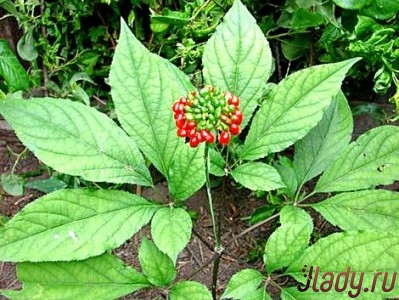Unhealthy skepticism
It is worth noting that the first of the Europeans,Nikolai Spafariy, a native of Moldova, head of the embassy of Tsar Alexei Mikhailovich in China, was the one who announced the power of ginseng: "And that root is boiled and given to those who are weak from long illness, and it gives great help." However, ginseng had sporadically visited Europe before: in the 9th century, the Arabs were already supplying it from Asia, a little later the authoritative Avicenna mentioned the properties of the root in the "Canon of Medicine", and at the end of the 13th century, the Venetian Marco Polo brought the "gift of immortality" to try. However, it was the Dutch merchants who were destined to promote the Manchu root, distributing it under the Latin name "ginseng" or "panax".
Legends
Rumor has it that ginseng is born from lightning.If it strikes the clear mirror water of a mountain spring, the spring will go underground, and in its place will take root a panzui concealing the power of heavenly fire. During flowering, on one of the nights, ginseng gives off a special glow, and the one who has obtained it can resurrect even the dead.
Have finished!
The last dynasty of Qing emperors brought towhite heat not only the country, but also the ginseng population. For centuries, the empire's soldiers walked the length and breadth of the forest, tracking down poachers. Subsequently, the state began to issue licenses for collection; an average of one and a half thousand annually. Rooters gathered in groups of 12-15 people and, under constant supervision from above, extracted the root.
Habitat
Today, only three isolated ones remainThe areas where the "root of life" lives are the southern Sikhote-Alin, Nadezhdinsky and Khasansky districts of Primorsky Krai and the Chinese provinces of Jilin and Heilongjiang. The most preferable for wild ginseng are cedar-deciduous forests, occasionally forests of spruce and black fir, as well as oak forests with an admixture of linden and aspen. Closer to the border with China, the plant can often be found next to yellow birch and in hornbeam cedar forests. An experienced root specialist knows that the healing root loves warmth and is very sensitive to cold. The long-liver (up to 200-400 years!) is characterized by shaded places (but illuminated by the sun in the first half of the day) with high humidity.
Than useful?
Ginseng root makes a person lesssusceptible to diseases, increases metabolism and, accordingly, restores strength and efficiency. It also improves appetite, makes the heart rhythm more rare, regulates blood pressure, promotes faster healing of wounds. Chinese pharmacists always prescribe drugs from the root to the elderly: however, they do not recommend it to children, with hypertension and summer heat. In Korea, both the root and the leaves are used.
Disappearing view
High cost and even higher demandaggravated its already illegal collection and smuggling. More than three thousand tons of the root pass through the world ginseng market - Hong Kong - every year.
Prejudice
Usually ginseng is dug up in the evening, exactlysunset, so that the root is exposed to light and dryness for as little time as possible. It is carefully removed from the soil with a special spatula in order to preserve it in its original form. According to the unwritten laws of the rooter's ethics, all ripe fruits should be collected and planted back in the soil. They go in search of ginseng without weapons, armed only with a stick called a pantsuyka. The stick is the rooter's faithful companion: it should be light and strong, preferably made of maple, reaching one and a half meters in length. The hunter invariably leans on it when climbing and descending, when crossing a river; he also uses it to push aside the grass, looking out for the coveted leaves. Often, an unarmed hunter himself became a victim: before Mao Zedong came to power, the forests were roamed not so much by thousands of desperate rooters as by miniature armies of daredevils - Honghuzes, taiga robbers. However, even today, ginseng rhizome seems like an extreme and unforgettable journey. Let's understand the terms Ginseng hunting is called rhizome, ginseng collectors call themselves rhizome-pickers. Even in ancient times, Chinese collectors created a special ginseng language called "hao - shu - hoa". Initially, the language is overly laconic, but eloquent: rhizome-pickers put conventional signs on trees and marks on bushes. According to custom, rhizome "by - red" lasts from August to mid-September, when ginseng berries are actively ripening. Nevertheless, the overwhelming majority of hunters do not shy away from rhizome "by shoots" (May - June), "by leaf (by stem shape) and "by - yellow", when the leaves acquire a yellowish tint in autumn. Root code A true ginseng hunter must follow three rules: do not take small roots, do not take roots before the seeds are ripe, and do not take roots previously found by others and marked with signs. Usually, an ordinary root weighing 15-20 g is found, although some manage to find half-century-old roots (40-50 g). As befits the king of plants, ginseng often acquires a personal name akin to "Emperor" or "Great Hermit": something similar happened in 1908, when a root weighing 600 g was found during the construction of the Manchurian Railway.
Who seeks will always find
Usually on a cedar tree closest to whereginseng was found, from the side facing this place, the bark is torn off - the podlub. Classic podlub is made about 20 cm wide and up to 80 cm long, and in this way it is preserved for decades and is visible from afar. This sign signifies that if a root or a whole family was once dug up here, then the fallen seeds, small or large "sleeping" roots could remain.
Taiga law
The rooter thus shares a secret.with his colleagues in the shop. The finder also has the right to put a mark by sticking a stick in, as if to say, "I found it, but left it to grow." However, nowadays many disdain the law and pull out roots without observing a single rule. Therefore, they increasingly resort to breaking: an experienced root-digger constantly breaks off branches of the bush on the go. Breaks are preserved less than underbark, but they are also much more difficult to notice.
How to communicate?
As a rule, you should not shout or whistle.They hit a smooth, even coniferous tree with a stick, from the bottom up, along the trunk so that most of the stick rests on it. The sound of "tak - tak - tak" on a slope sounds like "knock - tak - tak": it might sound like a woodpecker, and at that time you and your friends are getting together.
How to dig?
A circular formation is made around the neck (rhizome)trench. Then free the neck with the head from the ground and determine the size of the root. After that, from any edge of the trench, dig up the root shoots with bone sticks, feel all the hairs under the layer of loosened soil with your fingers and, making shaking movements, slowly free them in a circle. Having freed the entire "beard" of the root from the ground, dig up the main shoots and the body of the root in the same way. The dug up roots are immediately placed in an envelope made of cedar bark. The bottom of the envelope is covered with a layer of moistened moss (2 - 3 cm thick); then there is a layer of soil sifted through a sieve taken on the spot. Carefully folded roots are covered with the same layer of moss and soil. The edges of the envelope are folded and the newly formed "box" is tied with twine. When packed in this way, the roots do not spoil for 10-12 days: try to get to the last and most important moment of selling the treasure as quickly as possible. We have already told you about the unusual truffle hunt. The hunt for the "root of life" is no less exciting and interesting - an authentic trade of the Manchurians, bringing both fabulous profits and sorrows and hardships. Author:








